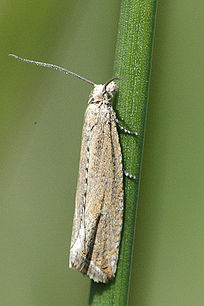- Tortricidae
-
Tortricidae 
Bactra lancealana Scientific classification Kingdom: Animalia Phylum: Arthropoda Class: Insecta Order: Lepidoptera Suborder: Glossata Infraorder: Heteroneura Section: Cossina Subsection: Cossina Superfamily: Tortricoidea Family: Tortricidae
Latreille, 1803Subfamilies & Tribes See also Taxonomy of Tortricidae for full list of genera.
Diversity Over 1000 genera
Over 9,400 speciesSynonyms Olethreutidae
Tortricidae is a family of moths, commonly known as tortrix moths, in the order Lepidoptera. Tortricidae is a large family with over 9,400 species described, and is the sole member of the superfamily Tortricoidea. Many of these are economically important pests. Olethreutidae is a junior synonym. The typical resting posture is with the wings folded back producing a rather rounded profile.
Contents
Some common Tortricids
The Tortricids include many economically important pests, including :-
- Summer fruit tortrix moth (Adoxophyes orana)
- Fruit tree tortrix moth (Archips podana)
- Rose leaf roller (Archips rosana)
- Argyrotaenia ljungiana, a pest on vines, maize and fruit trees
- Peach moth (Cydia molesta)
- Codling moth (Cydia pomonella)
- Plum fruit moth (Cydia funebrana)
- Pea moth (Cydia nigricana)
- Chestnut and acorn moth (Cydia splendana)
- Grape berry moth (Endopiza viteana)
- Light brown apple moth (Epiphyas postvittana)
- Hemp borer (Grapholita delineana)
- Oriental fruit moth (Grapholita molesta)
- Cherry fruitworm (Grapholita packardi)
- Vine moth (Lobesia botrana)
- Barred fruit tree tortrix moth (Pandemis cerasana)
- Long-palped tortrix (Vine leaf roller) (Sparganothis pilleriana)
- Bud moth (Spilonota ocellana)
- False codling moth (Thaumatotibia (Cryptophlebia) leucotreta)
See also Mexican jumping bean moth (Cydia deshaisiana)
A typical tortricid - the Codling moth
Tortricidae is considered to be the single most important family of insects that feed on apple, both economically and in diversity of feeding found on fruit, buds, leaves and shoots. In New York state, no less than 17 species of Tortricidae have gained pest status in regards to apple production.
The Codling moth Cydia pomonella is the species which causes worm-holes in apples. It has been accidentally spread from its original range in Europe and is now found in North and South America, South Africa, Australia and New Zealand wherever apples are grown. Control has required the use of the harshest available insecticides - historically lead arsenate and DDT were used. These chemicals brought considerable environmental dangers, and in any case the insect gradually developed resistance to them. Currently organophosphate sprays are favoured, timed carefully to catch the hatching larvae before they can bore into the fruit.
See also
References
- Firefly Encyclopedia of Insects and Spiders, edited by Christopher O'Toole, ISBN 1-55297-612-2, 2002
External links
- British Tortricoid Moths.
- Tortricid.net
- Family Tortricidae at Lepidoptera.pro
- Eurasian Tortricidae
- Tortricid Fauna of Apple In New York.(LEPIDOPTERA: TORTRICIDAE): Including An Account Of Apples' Occurrence In The State, Especially As A Naturalized Plant, written by P.J. Chapman and S.E. Link, Geneva: New York State Agricultural Experiment Station, 1971
- Rhyacionia frustrana, Nantucket pine tip moth on the UF / IFAS Featured Creatures Web site
Categories:- Moths
- Tortricoidea
- Tortricidae
Wikimedia Foundation. 2010.
